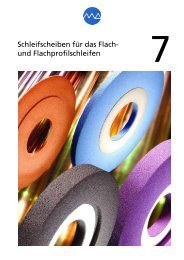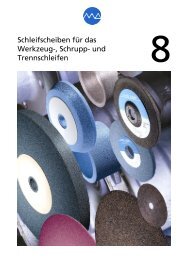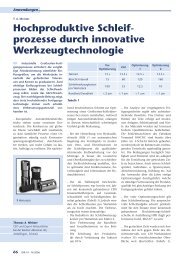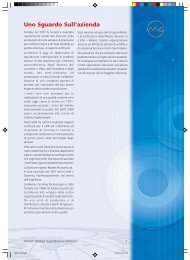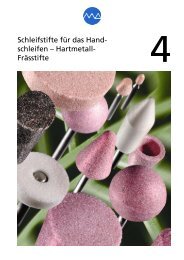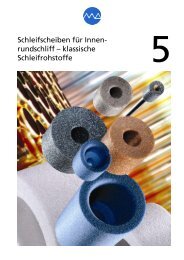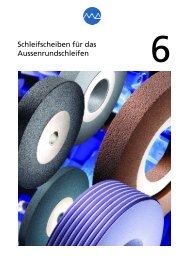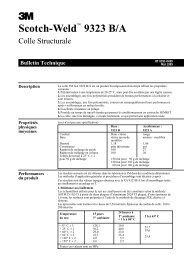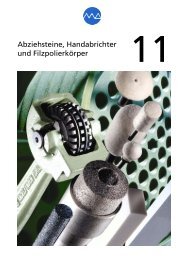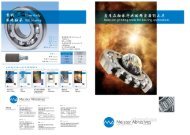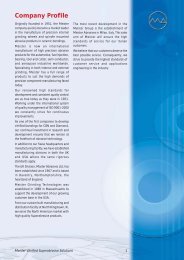Innovative flat honing with vitrified-bond grinding and - Meister ...
Innovative flat honing with vitrified-bond grinding and - Meister ...
Innovative flat honing with vitrified-bond grinding and - Meister ...
Create successful ePaper yourself
Turn your PDF publications into a flip-book with our unique Google optimized e-Paper software.
The <strong>flat</strong> <strong>honing</strong> process has long been established for the<br />
high-precision machining of ceramic, metal <strong>and</strong> polymer<br />
components when the very highest degrees of planeparallelism<br />
are required [1]. Unlike <strong>with</strong> <strong>grinding</strong> in which<br />
there is an increasing trend towards high-speed <strong>grinding</strong><br />
processes [2], such as for example external cylindrical, peel<br />
<strong>grinding</strong> <strong>and</strong> deep <strong>grinding</strong> where the contact between the<br />
tool <strong>and</strong> the <strong>grinding</strong> body is primarily linear, <strong>with</strong> <strong>flat</strong> <strong>honing</strong><br />
the surfaces that are being machined are in almost 100%<br />
The ever-increasing dem<strong>and</strong>s on<br />
components in terms of dimensional,<br />
geometric <strong>and</strong> positional tolerances, <strong>and</strong><br />
also the objective of reducing costs<br />
through continuous process improvement,<br />
can be met only through close cooperation<br />
between the tool manufacturer <strong>and</strong> the<br />
machine builder. With <strong>flat</strong> <strong>honing</strong>, new<br />
systems are increasingly enabling further<br />
increases in material removal rates to be<br />
achieved through faster cutting speeds.<br />
This article describes the optimising<br />
of a <strong>flat</strong> <strong>honing</strong> system, also called ‘Clean<br />
lapping <strong>with</strong> planetary kinematics’ [1],<br />
<strong>with</strong> which today virtually any material,<br />
from soft plastic through (sintered) metals<br />
<strong>and</strong> ceramics to high-strength PCD<br />
composites, can be machined in a reliable<br />
process using suitable <strong>grinding</strong> <strong>and</strong><br />
conditioning tools.<br />
The state of the art<br />
The twin-disc principle of the lapping<br />
process <strong>with</strong> planetary kinematics (loose<br />
abrasive grit) has been established for a<br />
long time. Conventional machines used<br />
in this area have a so-called C-frame<br />
construction. Because of the use of oils<br />
<strong>and</strong> un<strong>bond</strong>ed lapping pastes the process<br />
is relatively cleaning-intensive, which is<br />
critical both <strong>with</strong> regard tocost per part as<br />
<strong>with</strong> regard to possible disposal problems.<br />
The introduction of tools <strong>with</strong> <strong>bond</strong>ed<br />
INDUSTRIAL DIAMOND REVIEW 4/05<br />
abrasive, e.g. diamond or cubic boron<br />
nitride (CBN), is therefore to be seen as<br />
a major innovation for the development<br />
of the process generally.<br />
The first applications involved the use of<br />
<strong>grinding</strong> tools <strong>with</strong> resin <strong>and</strong> metal <strong>bond</strong>s.<br />
However, the process forces resulting from<br />
the large contact areas <strong>with</strong> the parts led<br />
to many difficulties <strong>with</strong> both the machine<br />
<strong>and</strong> the process. As only few changes were<br />
made to the machines parameters <strong>and</strong><br />
control systems to make them specifically<br />
suitable for <strong>flat</strong> <strong>honing</strong>, very little progress<br />
was made for a long time.<br />
It was only <strong>with</strong> the use of <strong>vitrified</strong><strong>bond</strong><br />
tools that significant progress<br />
was made compared <strong>with</strong> conventional<br />
lapping methods [3]. A further step<br />
forward was in tool design in the form of<br />
individual pellets, which as well as the<br />
concentration calibrates the number of<br />
cutting edges engaging the workpiece<br />
due to the pattern <strong>with</strong> which a wheel is<br />
covered. For a long time however relatively<br />
little development work has been carried<br />
out on the <strong>vitrified</strong> <strong>bond</strong> of the CBN <strong>and</strong><br />
the diamond itself. Generally, existing<br />
systems of other processes were just<br />
slightly modified <strong>and</strong> adapted.<br />
Furthermore, until now the conditioning<br />
of the <strong>grinding</strong> tools has not been a very<br />
reliable process. The usual process for<br />
sharpening diamond wheels for example<br />
is the use of soft corundum stones [4],<br />
Diamond technology<br />
<strong>Innovative</strong> <strong>flat</strong> <strong>honing</strong><br />
<strong>with</strong> <strong>vitrified</strong>-<strong>bond</strong><br />
<strong>grinding</strong> <strong>and</strong><br />
conditioning tools<br />
contact <strong>with</strong> the tool. Despite the lower cutting speeds,<br />
this results in high material rates characterised by a low<br />
thermal load <strong>and</strong> little warping of the components. Due<br />
to the characteristic planetary kinematics there are different<br />
loads on the individual abrasive grits, <strong>with</strong> a resulting wear<br />
pattern as a function of the disc pitch. This must always be<br />
taken into consideration in the design of the tool, of the<br />
machine, in application <strong>and</strong> also when conditioning. This<br />
article by P. Beyer <strong>and</strong> M. v. Ravenzwaaij.<br />
SiC rings mounted on the rotor discs, or<br />
loose abrasive. All these methods require<br />
a great deal of experience, take a long<br />
time <strong>and</strong> because of the fact that they<br />
depend on the operator’s skills, they are<br />
only reliable to a limited extent.<br />
The basic principle of the workpiece/<br />
tool arrangement <strong>and</strong> also the relative<br />
movement between the two due to the<br />
planetary kinematics are shown in Fig 1a<br />
<strong>and</strong> Fig 1b. The wear patterns that are<br />
produced on the tool as a result of this<br />
are shown schematically in Fig 2.<br />
The limit of any process is determined<br />
by the weakest link in the chain. An<br />
innovative improvement in the process<br />
is therefore only possible <strong>with</strong> a new<br />
design of the system as a whole, which<br />
can only be successful <strong>with</strong> coordinated<br />
development both of the machine <strong>and</strong><br />
the tool.<br />
Machine development<br />
Any new machine concept must take<br />
the following basic factors into account:<br />
◆ a stable torsionally stiff<br />
machine concept<br />
◆ a wide range over which<br />
the cutting speed can be varied<br />
◆ it must be possible to adapt<br />
(increase) the force that can be<br />
applied to the workpiece materials<br />
47
Diamond technology<br />
The main design difference compared<br />
<strong>with</strong> existing systems is the bridge design,<br />
which may be regarded as the ideal<br />
design, used in the new DLM 05 series<br />
(DLM 705, DLM 1005, DLM 1505). In the<br />
balance beam systems hitherto (<strong>with</strong> or<br />
<strong>with</strong>out a swivelling head), the bearing<br />
area was one weak point of the C-frame<br />
construction. The bridge-type design<br />
does not have this disadvantage. The<br />
structure optimised <strong>with</strong> this type of<br />
design enables machining forces of up<br />
to four tonnes to be involved. Other<br />
design improvements include uncoupling<br />
all the motors from the drive shafts, i.e.<br />
any deformation that might occur no<br />
longer depends on the power, a speed<br />
increased to 400 rpm (in current tests this<br />
is even up to 2000 rpm), <strong>and</strong> much<br />
improved accessibility for the operator.<br />
With this, the key machining parameters<br />
48<br />
Fig 1a Arrangement of the machining area of a <strong>flat</strong> <strong>honing</strong> machine<br />
Upper working<br />
wheel<br />
Lower<br />
working wheel<br />
Fig 2 Possible wear pattern<br />
on tools for <strong>flat</strong> <strong>honing</strong><br />
Fig 3 The Stähli DLM 705<br />
as contact pressure <strong>and</strong> cutting speed,<br />
in relation to stock removal, can be selected<br />
to specifically suit the workpiece material<br />
<strong>and</strong> the workpiece.<br />
A summary of the technical parameters<br />
that are available is given in Table 1.<br />
These provide the essential conditions for<br />
the development of <strong>flat</strong> <strong>honing</strong> or fine<br />
<strong>grinding</strong> <strong>with</strong> planetary kinematics.<br />
In combination <strong>with</strong> the latest<br />
developments in tooling, such as HPB<br />
technology [5], from now on the weakest<br />
link in the chain is the workpiece itself, or<br />
the rotor disc (template) in which the<br />
workpiece is guided.<br />
Tool development<br />
As well as the basic design of the machine,<br />
the process is largely determined by the<br />
selection of suitable <strong>grinding</strong>/<strong>honing</strong><br />
<strong>and</strong> conditioning tools. Because of their<br />
advantages that are specific to the system,<br />
when designing high-performance <strong>grinding</strong><br />
or <strong>honing</strong> processes it is preferable to use<br />
<strong>vitrified</strong> <strong>bond</strong>s for the CBN <strong>and</strong> diamond<br />
abrasives. The main advantages are the<br />
very free-cutting topography of the <strong>grinding</strong><br />
tool, the low contact pressure that is<br />
needed as a result <strong>and</strong> the very short<br />
machining times that are possible while<br />
DLM 705 DLM 1005 DLM 1505<br />
Outer ∅ of the working wheels 500 - 720 mm 800 - 1250 mm 1300 - 1600 mm<br />
Number of rotor discs 4 - 7<br />
Distance between<br />
the working wheels<br />
also achieving an excellent geometry on<br />
the workpiece. A summary of the technical<br />
fundamentals of <strong>vitrified</strong>-<strong>bond</strong> tools can<br />
be found in reference [5]. Below we will<br />
deal only <strong>with</strong> the adjustments that are<br />
specific to <strong>flat</strong> <strong>honing</strong>.<br />
Fig 4<br />
Top: St<strong>and</strong>ard structure,<br />
grit size 230 mesh<br />
Bottom: Highly porous<br />
structure <strong>with</strong> defined<br />
pore radius distribution,<br />
grit size 230 mesh<br />
Fig 5 Composite technology<br />
<strong>vitrified</strong>-<strong>bond</strong> CBN wheel<br />
Fig 6 Technical design to stabilise the edge<br />
zone of a CBN/diamond wheel for <strong>flat</strong> <strong>honing</strong><br />
(schematic) – goldfish pellets<br />
INDUSTRIAL DIAMOND REVIEW 4/05<br />
Grinding wheel specifications<br />
Due to the large contact surfaces, in order<br />
to achieve a high material removal rate<br />
generally a relatively low CBN/diamond<br />
concentration in the range C50-C75<br />
should be chosen <strong>with</strong> as porous a<br />
structure as possible. The wide range of<br />
options for adjusting the parameters of<br />
abrasive concentration, pore volume <strong>and</strong><br />
pore radius distribution is available only<br />
<strong>with</strong> <strong>vitrified</strong> <strong>bond</strong>s. The porous structure<br />
ensures the supply of coolant <strong>and</strong> chip<br />
removal <strong>and</strong> can be adjusted <strong>with</strong> regard<br />
to pore volume <strong>and</strong> pore radius distribution<br />
(Fig 4).<br />
Due to the large contact surfaces <strong>and</strong><br />
the large amount of chips that are<br />
produced in <strong>flat</strong> <strong>honing</strong>, this function is<br />
also determined, or helped, by the<br />
distance between the pellets, which are<br />
usually hexagonal. As the abrasive layer<br />
is increasingly worn away, due to the<br />
reducing depth of the gap the layer is<br />
worn away almost entirely. To avoid this<br />
negative effect the pellets can be<br />
provided <strong>with</strong> a <strong>vitrified</strong> substrate (blind<br />
layer) (Fig 5).<br />
Composite tool technology<br />
These structures, called composite tools<br />
or pellets, are produced economically by<br />
a combined pressing of the abrasive <strong>and</strong><br />
the blind layer. Due to the nature of the<br />
ceramic manufacturing process, the blind<br />
layer must be adapted to the thermal<br />
<strong>and</strong> physical properties of the abrasive<br />
layer so that in the consolidating firing<br />
process they are sintered such that they<br />
are free of stresses. The factors of grit size<br />
<strong>and</strong> concentration, coefficient of thermal<br />
expansion <strong>and</strong> sintering shrinkage must be<br />
adjusted accordingly.<br />
∅190<br />
30<br />
10<br />
10 +0.2<br />
-0<br />
8 +0.2<br />
-0<br />
∅205<br />
∅245<br />
Design details<br />
Diamond technology<br />
In order to optimise the <strong>grinding</strong> wheel<br />
for a more reliable running-in of the<br />
workpiece components, the fringe area<br />
of the wheels has been redesigned to<br />
prevent there being too many gaps at<br />
the edge of the wheel, the external <strong>and</strong><br />
the internal diameter are coated <strong>with</strong><br />
double pellets, so-called ‘goldfish pellets’<br />
(Fig 6).<br />
Dressing/conditioning tools<br />
In order to optimise the entire <strong>grinding</strong><br />
process on the tooling side, it is a matter<br />
for discussion as to whether new<br />
approaches are possible in the selection<br />
of the conditioning tool that in terms of<br />
quality <strong>and</strong> the time needed can shorten<br />
the lengthy setting process. As well as the<br />
levelling of CBN abrasive layers, above all<br />
the problems involved in the reconditioning<br />
of diamond tools have so far not been<br />
resolved very satisfactorily.<br />
The basic approach for designing new<br />
dressing tools as far as the <strong>bond</strong> is<br />
concerned is that of vDD technology<br />
(<strong>vitrified</strong> Diamond Dresser), namely <strong>vitrified</strong><strong>bond</strong><br />
diamond tools [6]. The known<br />
advantages in terms of lower dressing<br />
forces, efficient ‘free-cutting’ conditioning<br />
<strong>and</strong> excellent <strong>grinding</strong> wheel levelling make<br />
these tools ideal for the conditioning of<br />
<strong>grinding</strong> wheels <strong>with</strong> a large surface area<br />
for <strong>flat</strong> <strong>honing</strong>.<br />
A corresponding design is shown in<br />
Fig 7, <strong>and</strong> in use in Fig 8. The conditioning<br />
tools, mounted on rotor discs, rotate <strong>and</strong><br />
are moved over the surface of the <strong>grinding</strong><br />
tool to match the flow of parts.<br />
Application examples<br />
The latest technical developments on<br />
the user side are leading increasingly to<br />
the use of new <strong>and</strong> usually hard-to-cut<br />
materials. Because their composition is<br />
largely independent of metallurgical<br />
Fig 7 vDD dressers of specification D11-120-P-8-280-X150-V86-39-2 Fig 8 Dressing <strong>and</strong> sharpening ring in use<br />
49
Diamond technology<br />
processes, sintered metals have increased<br />
considerably in importance both in terms<br />
of the materials <strong>and</strong> the manufacturing<br />
process. The method by which they are<br />
produced does however result in a<br />
hardness gradient of the material, which<br />
affects cuttability. Machining strategies to<br />
date have therefore required a two-stage<br />
process involving a turning operation<br />
that is carried out beforeh<strong>and</strong>.<br />
A machining process consisting solely<br />
of <strong>grinding</strong> has until now been hindered<br />
due to the rapid loss of a tool’s free-cutting<br />
properties <strong>and</strong> the consequent need for<br />
frequent sharpening, or the wear on the<br />
tool <strong>with</strong> a loss of the geometry of the<br />
<strong>grinding</strong> wheel.<br />
As a result this also had an adverse effect<br />
on the vibration behaviour of the machine,<br />
which meant that it was not possible to<br />
50<br />
produce the workpieces <strong>with</strong>in the<br />
required dimensional tolerances.<br />
In the example described (1), <strong>with</strong><br />
modern <strong>flat</strong> <strong>honing</strong> technology this<br />
machining can be reduced to a reliable<br />
single-stage process.<br />
With the use of HPB <strong>grinding</strong> tool<br />
technology on the new DLM 705 this can<br />
be improved significantly. Shorter <strong>and</strong><br />
more constant machining times <strong>with</strong> better<br />
quality, much longer periods between<br />
conditioning <strong>and</strong> reduced burr formation<br />
guarantee a production process that is<br />
productive <strong>and</strong> reliable.<br />
Another application example (2) for the<br />
machining of 100 Cr 6 components for an<br />
optimised process of machine, machining<br />
tool <strong>and</strong> conditioning wheel confirms the<br />
optimum design of the entire concept by the<br />
machine manufacturer <strong>and</strong> the tool supplier.<br />
Application example 1:<br />
Combination Stähli DLM 705, <strong>Meister</strong> HPB Vit-CBN <strong>and</strong> vDD technology<br />
Application Flat <strong>honing</strong> on Stähli DLM 705 <strong>with</strong> oil<br />
Material Sintered steel D<br />
Allowance 0.3 mm or 300 µm<br />
Number of parts/load 6 rotor discs <strong>with</strong> 10 parts = 60 parts<br />
Coating 19%<br />
Honing tool Swiss Master HPB Vit-CBN CB56-170-P-11-215-X75-V51-31<br />
Dressing tool <strong>and</strong> sharpening tool Swiss Master vDD D11-120-P-8-280-X150-V86-39-2<br />
Results Swiss Master HPB Vit-CBN St<strong>and</strong>ard<br />
◆ machining time/load 2 min 3 - 7 min<br />
◆ machining time/workpiece 2 s 3 -7 s<br />
◆ dimensional stability ±1 µm ±2 µm<br />
◆ R z 2 - 3 µm 2 -3 µm<br />
◆ <strong>flat</strong>ness 0.5 µm 1 -1.5 µm<br />
Dressing interval after assembly 30 s once a day 60 s<br />
Sharpening interval once a day 20 s<br />
Application example 2:<br />
Combination Stähli DLM 705, <strong>Meister</strong> Vit-CBN <strong>and</strong> vDD technology<br />
Application lat <strong>honing</strong> on Stähli DLM 705 <strong>with</strong> oil<br />
Material 100 Cr 6<br />
Allowance 0.2 mm or 200 µm<br />
2 – 3 times per shift 60 s<br />
(<strong>with</strong> > 7 mins machining time)<br />
Number of parts/load 6 rotor discs <strong>with</strong> 390 parts = 2340 parts<br />
Honing tool Swiss Master HPB Vit-CBN CB56-1450-P-9-260-50-V51-32<br />
Dressing tool <strong>and</strong> sharpening tool Swiss Master vDD D11-120-P-8-280-X150-V86-39-2<br />
Results Swiss Master HPB Vit-CBN St<strong>and</strong>ard<br />
◆ machining time/load 2.5 min 2.5 - 7 min<br />
◆ machining time/workpiece 0.065 s 0.065 - 0.18 s<br />
◆ dimensional stability ± 1.5 µm ±3 µm<br />
◆ R z 0.6 - 0.8 µm 0.8 - 2.5 µm<br />
Dressing interval after assembly 30 s after assembly 60 s<br />
Sharpening interval after approx. 150,000 parts after approx. 100,000 parts<br />
Prospects<br />
The general trend in favour of <strong>vitrified</strong><strong>bond</strong><br />
high-performance tools should<br />
continue in the area of <strong>flat</strong> <strong>honing</strong> as well,<br />
not least due to the machine concepts<br />
which are now much more suitable. In<br />
future, the combination of vDD technology<br />
<strong>with</strong> the conditioning of <strong>vitrified</strong>-<strong>bond</strong><br />
diamond tools for the <strong>flat</strong> <strong>honing</strong> of, for<br />
example, ceramics, will also be the<br />
subject of detailed tests.<br />
The application examples that have<br />
been described show clearly that it is<br />
only through close cooperation between<br />
the machine builder <strong>and</strong> the tool supplier<br />
that the total machining system can be<br />
fully optimised. Both innovative machine<br />
concepts <strong>and</strong> also new approaches in<br />
the areas of tool development, carried out<br />
in close coordination one <strong>with</strong> the other,<br />
enable the user to increase productivity<br />
significantly. ◆<br />
References<br />
[1] Stähli, A.W. ‘Läppen und Flachhonen<br />
mit Zweischeiben-Maschinen’<br />
[Lapping <strong>and</strong> <strong>flat</strong>-surface <strong>honing</strong> <strong>with</strong><br />
twin-disc machines], A.W. Stähli AG<br />
company literature (1998) (In German).<br />
[2] Yegenoglu, K. ‘Maschinentechnische<br />
Voraussetzungen zum<br />
Hochleistungsschleifen’ [Machine<br />
requirements for high-performance<br />
<strong>grinding</strong>], 7. Int. Braunschweig. FBK,<br />
IWF series of publications, Vulkan-<br />
Verlag Essen (1993) (In German).<br />
[3] Dennis, P., Preising, D., v. Mackensen,<br />
V., Longerich, W. ‘Feinschleifen<br />
Substitution des Läppens’ [Fine<br />
<strong>grinding</strong> – a substitute for lapping],<br />
Schleiftechnisches Kolloquium<br />
Aachen 1997, VDI Verlag 1997, 16-1<br />
(In German).<br />
[4] Benguerel, R. ‘Feinschleifen<br />
technischer Keramik mit Diamant-<br />
Cluster-Scheiben’ [Fine <strong>grinding</strong> of<br />
engineering ceramic <strong>with</strong> diamond<br />
cluster wheels], IWF Kolloquium 2000<br />
(In German).<br />
[5] Beyer, P. ‘HPB technology for<br />
<strong>vitrified</strong>-<strong>bond</strong> CBN <strong>grinding</strong> wheels’,<br />
IDR 1/2005.<br />
Dr.-Ing. Peter Beyer is the Engineering,<br />
R&D <strong>and</strong> Production Manager of <strong>Meister</strong><br />
Abrasives AG, Andelfingen, Switzerl<strong>and</strong>.<br />
Marc van Ravenzwaaij is a TS applications<br />
engineer <strong>with</strong> A.W. Stähli AG, Pieterlen,<br />
Switzerl<strong>and</strong>.<br />
INDUSTRIAL DIAMOND REVIEW 4/05




